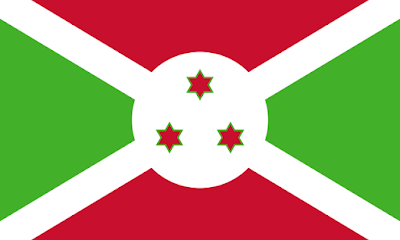Flag of Burundi, A symbol of unity and progress
Flags are powerful symbols that represent the identity, values and aspirations of a nation. The flag of Burundi, a small landlocked country in East Africa, holds significant meaning and reflects the country's rich history and cultural heritage. In this article, we'll delve deeper into the details of the Burundi flag, exploring its design, symbolism, and the message it conveys to its people and the world.
Design & Color:
The flag of Burundi features a tricolor design with three horizontal stripes of red, white and green running from top to bottom. In the center of the white band, there is a large white circle with three six-pointed stars arranged in a triangular shape. The red stripe at the top represents the bravery and courage of the Burundian people, while the white stripe symbolizes peace. The green stripe at the bottom symbolizes hope and the country's abundant natural resources.
Symbolism and Meaning:
Each element of the Burundi flag holds symbolic significance that represents the nation's values and aspirations. The three six-pointed stars in the white circle symbolize the three major ethnic groups in Burundi: Hutu, Tutsi and Twa. These stars are placed in a triangular formation, symbolizing unity, cooperation and harmony among the various ethnic groups that make up the diverse fabric of Burundian society. The stars also represent the three principles of the national motto: "Ubumwe, Ibikorwa, Iterambere" (Unity, Work, Progress), which reflect the country's commitment to building a prosperous future.
The colors red, white and green hold historical significance and reflect the shared values of the Burundian people. The red color represents the struggle for freedom and independence, as well as the sacrifice and bloodshed of those fighting for the sovereignty of Burundi. White symbolizes peace, reconciliation and hope for a peaceful future for all Burundians. The green color symbolizes the country's lush vegetation, agricultural wealth and aspirations for economic growth and prosperity.
Message and Significance:
The Burundi flag serves as a unifying symbol that brings together diverse ethnic groups and promotes national unity. It conveys the message of unity, peace and progress while highlighting the importance of cooperation and collaboration in building a harmonious society. The flag reminds the people of Burundi of their shared history, values and aspirations, thereby promoting a sense of national pride and identity.
Furthermore, the flag of Burundi represents the country's commitment to peace building and reconciliation, especially after a history marked by ethnic tensions and conflicts. It is a reminder of the importance of embracing diversity and working together towards a common goal of progress and development.
The flag of Burundi embodies the spirit, values and aspirations of the nation. Its design, colors and symbols symbolize unity, peace and progress. As Burundi continues its journey towards stability and development, the flag serves as a constant reminder of the Burundian people's shared heritage and collective aspirations. It is a symbol of hope, resilience and determination to build a brighter future for all citizens of Burundi.
Located in East Africa, Burundi has a diverse culinary tradition influenced by its geography, history and neighboring countries. The country's cuisine includes a variety of flavor's, ingredients and traditional dishes that reflect its cultural heritage. Here are some notable foods of Burundi:
foods of Burundi
- Ugali: Ugali is a staple food in Burundi, as in other countries in East Africa. It is a thick, tough porridge made from cornmeal or cassava flour. Ugali is often served as a side dish and eaten with various stews, sauces or vegetables.
- Beans: Beans play an important role in Burundian cuisine. They are a common ingredient in many cuisines and are usually cooked with spices, onions and tomatoes. Red kidney beans and black-eyed peas are commonly used varieties.
- Ibihaza: Ibihaza is a popular dish made from dried fish, especially sardines or mackerel. The fish is often sun-dried and then cooked with tomatoes, onions and various spices. It is usually served with Ugli or rice.
- Isombe: Isombe is a traditional dish made from cassava leaves. The leaves are cooked with peanuts, onions, garlic and palm oil to make a delicious and nutritious stew. Isombe is often served with grilled fish or meat.
- Brochettes: Brochettes are skewered meat kebabs that are commonly enjoyed in Burundi. They can be made with various meats such as beef, goat, or chicken, marinated in spices, and grilled over charcoal. Brochettes are often served with fries or a plantain.
- Mandazi: Mandazi are deep fried donut or bread rolls that are popular in Burundi as a breakfast or snack item. They are typically made from flour, sugar, yeast, and coconut milk, which gives them a slightly sweet and fluffy texture.
- Inyange: Inyange is a traditional milk drink made from fermented cow's milk. It is often consumed during special occasions and celebrations. Inyange has a pungent flavor and is sometimes mixed with honey or served as a yogurt-like consistency.
- Rwandan-style sambusa: Due to the close cultural ties between Burundi and Rwanda, Rwandan-style sambusa (similar to samosas) are also commonly found in Burundi. These triangular pastries are filled with various ingredients such as meat, vegetables or lentils and deep fried until crisp.
- Fruits: Burundi's tropical climate allows for the cultivation of a variety of delicious fruits. Some popular fruits include bananas, mangoes, pineapples, papayas and avocados. These fruits are often eaten fresh or used in juices and desserts.
- Urwagava: Urwagava is a traditional alcoholic drink made from bananas. It is brewed and fermented, resulting in a mild alcoholic beverage with a sweet and tart taste. Urwagwa is consumed during social gatherings and cultural ceremonies.

.jpg)
Comments
Post a Comment